

Everything about the Egyptian statuettes known as shabti or ushabti. Société d'égyptologie, Genève. Ce répertoire bibliographique recense, par grandes périodes de l’histoire égyptienne, les références bibliographiques portées à la connaissance du rédacteur depuis 1985.
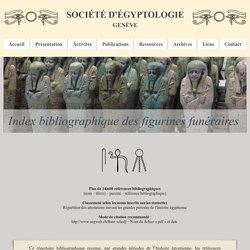
Ces références ont été régulièrement mentionnées dans les parutions successives du Bulletin de la Société d’Égyptologie, Genève, dès sa onzième livraison (BSÉG 11, 1987). On rappellera que ce répertoire est d’abord limité aux références bibliographiques. On accueillera donc avec reconnaissance toute information utile à compléter et enrichir les bases de données. En revanche, les informations inédites ne peuvent pas être prises en compte actuellement. L’utilisateur trouvera les abréviations utilisées dans les différents documents en consultant le fichier « bibliographie », également mise en ligne avec ces fichiers. Les informations proposées (nom, titre<s>, parent<s>, référence bibliographie) ne représentent qu’un extrait des données recueillies. Le blog de jean-yves cordier - Le partage de photographies de tout ce qui, dans la nature et dans la culture , porte les ailes de la grâce : un blog pour ouvrir autant de fenêtres que possible sur mon coin de Bretagne, autour de Brest et de Crozon, et un.
La première chose que l'on constatera, c'est que l'article Wikipédia qui concerne Jean-Antoine Coquebert de Montbret est en anglais, et qu'aucun entomologiste français n'a pris la peine d'écrire une notice biographique dans cette encyclopédie dans notre langue.

Nul n'est prophète en son pays. Red Digital de Colecciones de Museos de España - Búsqueda general. Museo Arqueológico Nacional - Resultados de la búsqueda. LACMA Collections. This sarcophagus, or coffin, including a base, lid, and mummy board, dates to the middle of the Twenty-first Dynasty (c. 1000-968 BC)....

This sarcophagus, or coffin, including a base, lid, and mummy board, dates to the middle of the Twenty-first Dynasty (c. 1000-968 BC). The high priests of Amun at Thebes assumed rule over Egypt in the Twenty-first Dynasty, and a number of changes took place in funerary customs. Beginning during the Old Kingdom (2687-2191 BC), tombs were built of permanent materials and the interior walls of the tombs were decorated with scenes of daily life and funerary rituals. They were also inscribed with texts to further ensure that the deceased would travel from life into the afterlife, as well as to provide sustenance for the deceased in the afterlife. More... Catalogo. Ushabti Reale.
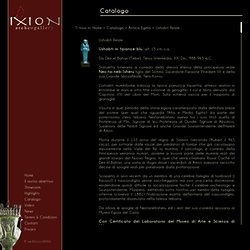
Ushabti in faiance blu, alt. 15 cm. c.a. Da Deir el Bahari (Tebe), Terzo Intermedio, XXI Din., 988-965 a.C. Image gallery: The Greenfield Papyrus. Full: Front 'Book of the Dead' of Nestanebtasheru (sheet 80): Nestanebisheru kneels before the balance where her heart is being weighed.
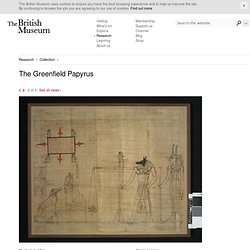
The operation is performed by the jackal-headed Anubis, god of embalming and guardian of cemeteries, and sitting atop the scales is a small baboon representing Thoth, the scribe of the gods, who ensured an accurate result. 15782. Shawabty of Nestanebisheru. Dimensions Height x width x depth: 15.1 x 5.6 x 3.9 cm (5 15/16 x 2 3 /16 x 1 9/16 in.)
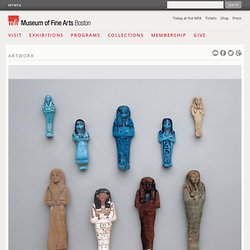
Accession Number Medium or Technique Faience Not On View Collections. Shawabty of Nestanebisheru. Shawabty of Nestanebisheru. Eternal Egypt The shawabti of King Taharqa that was found in his tomb at Nuri in Upper Nubia is shaped like a wrapped human body.
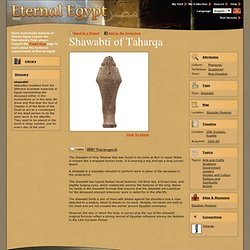
It is wearing a wig and has a long curved beard. A shawabti is a statuette intended to perform work in place of the deceased in the underworld. This shawabti has typical Nubian facial features: full thick lips, a broad nose, and slightly bulging eyes, which realistically portray the features of the king. Below his hands is the shawabti formula that ensures that the shawabti will substitute for the deceased pharaoh whenever work is called for in the afterlife. The shawabti holds a pair of hoes with blades against his shoulders and a rope attached to a basket, which is shown on his back.
Sunk Relief, inscribed for Ptahshepses, called Impy, Superintendent of the palace and his family. Egyptian Blue Pigment - Natural Pigments. Trip to the royal cache DB320 / TT320. Musée des Beaux Arts et d'Archéologie de Besancon - Label Musée de France. Search object details. Registration numbers The most common type of Museum number begins with the year of acquisition.
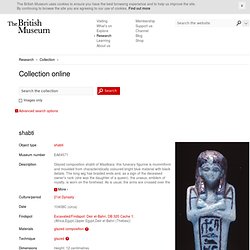
The database standardises these numbers in the form, for example: 1887,0708.2427 (year: comma: block of four numbers - usually representing a month and day: full-stop and final number). The final number can be of any length and may be followed by another full-stop and a sub-number. In some cases the same number is shared by two or more objects across departments. In some of these cases a prefix has been added before a number (e.g. If the number you are entering has come from an old catalogue it could appear in the form 1887-7-8-2427.
In the case of some two-dimensional works from Asia and the Middle East a full stop may need to be inserted into the final number. The second most common type of Museum number takes the form of one or two letters followed by two numbers. BM or 'Big' numbers Other numbering systems Sir Percival David Collection of Chinese Ceramics Chinese and Japanese paintings.